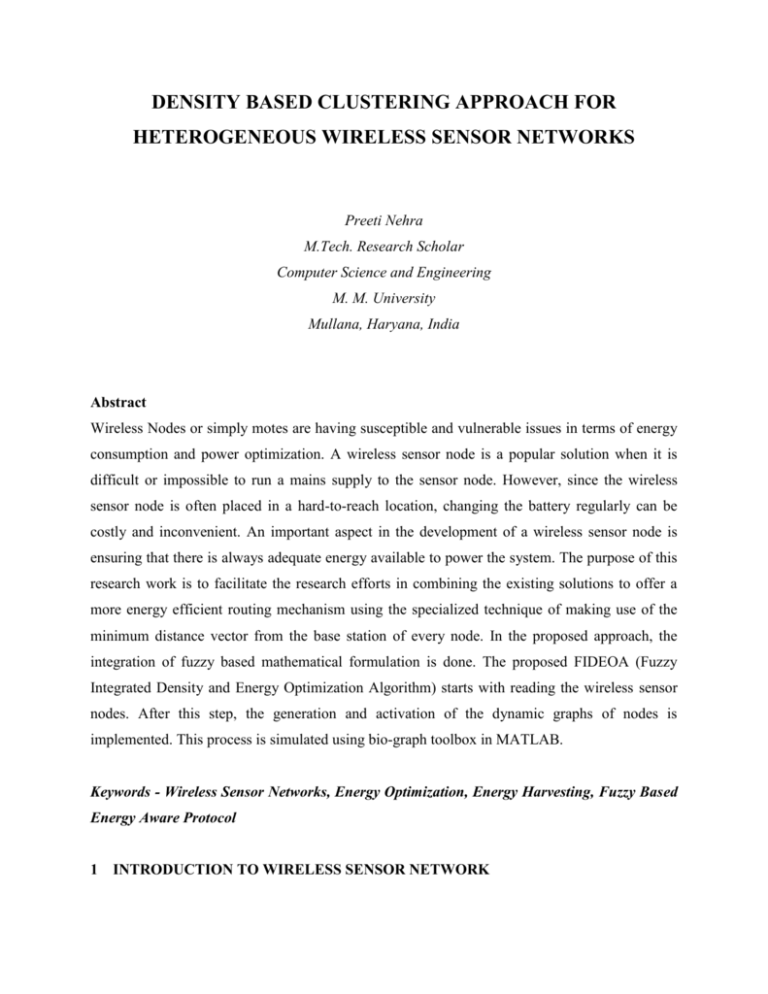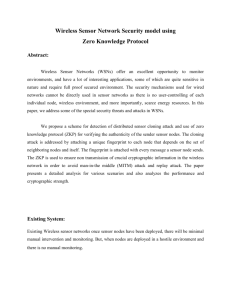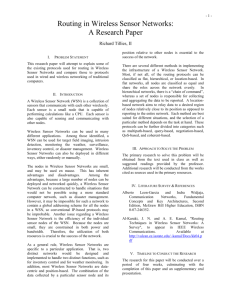432927732preeti_research_paper
advertisement

DENSITY BASED CLUSTERING APPROACH FOR
HETEROGENEOUS WIRELESS SENSOR NETWORKS
Preeti Nehra
M.Tech. Research Scholar
Computer Science and Engineering
M. M. University
Mullana, Haryana, India
Abstract
Wireless Nodes or simply motes are having susceptible and vulnerable issues in terms of energy
consumption and power optimization. A wireless sensor node is a popular solution when it is
difficult or impossible to run a mains supply to the sensor node. However, since the wireless
sensor node is often placed in a hard-to-reach location, changing the battery regularly can be
costly and inconvenient. An important aspect in the development of a wireless sensor node is
ensuring that there is always adequate energy available to power the system. The purpose of this
research work is to facilitate the research efforts in combining the existing solutions to offer a
more energy efficient routing mechanism using the specialized technique of making use of the
minimum distance vector from the base station of every node. In the proposed approach, the
integration of fuzzy based mathematical formulation is done. The proposed FIDEOA (Fuzzy
Integrated Density and Energy Optimization Algorithm) starts with reading the wireless sensor
nodes. After this step, the generation and activation of the dynamic graphs of nodes is
implemented. This process is simulated using bio-graph toolbox in MATLAB.
Keywords - Wireless Sensor Networks, Energy Optimization, Energy Harvesting, Fuzzy Based
Energy Aware Protocol
1
INTRODUCTION TO WIRELESS SENSOR NETWORK
Wireless Sensor Networks (WSNs) [1] have been widely considered as one of the most
important technologies for the twenty-first century. Enabled by recent advances in
microelectronic mechanical systems (MEMS) and wireless communication technologies, tiny,
cheap, and smart sensors deployed in a physical area and networked through wireless links and
the Internet provide unprecedented opportunities for a variety of civilian and military
applications, for example, environmental monitoring, battle field surveillance, and industry
process control. Distinguished from traditional wireless communication networks, for example,
cellular systems and mobile ad hoc networks (MANET), WSNs have unique characteristics, for
example, denser level of node deployment, higher unreliability of sensor nodes, and severe
energy computation, and storage constraints, which present many new challenges in the
development and application of WSNs [2].
1.1 APPLICATIONS OF WIRELESS SENSOR NETWORKS
A large number of potential applications of sensor networks have been reported ranging from
early research investigations to commercial systems. A broad range of applications is given
below [4]:
Environmental Monitoring
Animal Tracking And Control
Safety, Security and Military Applications [5]
Built Environment [6]
Health [7]
1.2 DESIGN AND CHALLENGES IN WIRELESS SENSOR NETWORKS
The advances in wireless sensor networks, while promising, have also posed challenges, such as
resource limitations, dynamic environment and various application needs. These challenges and
tradeoffs are discussed as follows [8]:
1.2.1 Sensor Platform
For a successful large scale deployment of wireless sensor networks, each node must have low
power consumption, low operating and system cost and a small form factor.
1.2.2 Network Construction and Maintenance
Two key challenges in the deployment of WSN are the large number of devices involved and the
necessity to embed them in a dynamic physical environment. For example, consider a
surveillance sensor network that is deployed in the Line of Control (LoC) area. Deployment of
this network can be done by dropping a large number of sensor nodes from a plane. In this
example and in many other anticipated applications, it is not possible to deploy the nodes in a
regular fashion (linear array, 2D lattice). More importantly, uniform deployment does not
correspond to uniform connectivity owing to obstructions, interference and other environmental
factors. Thus the deployed network must be designed to operate under environmental dynamics
while preserving reliability in the sensing coverage and network connectivity.
1.2.3 Data Dissemination and Collection
Basic capabilities in WSN involve mechanisms like routing, tunneling, data aggregation,
clustering to collect information from nodes and forward them to a sink node. Based on the size
of the deployment, the number of sink nodes can be increased. Due to power restrictions and
environmental dynamics of WSN, these mechanisms have to be of low power, scalable with the
number of nodes and tolerant to malpractice. Moreover, some sensor nodes may fail or get
blocked due to lack of power, physical damage, or environmental interference. This causes
topological changes in WSN [9]. In order to overcome these challenges, the mechanisms
involved in WSN need to be adaptive.
1.2.4 Localization
The purpose of localization is the provision of some kind of location information to the nodes in
the network. Using the location knowledge of nodes, the place of occurrence of the phenomenon
can be easily determined. Further, it also helps in developing energy efficient routing algorithms.
The most immediate solution is the use of a physical coordinate system enabled by equipping all
nodes with a GPS (Global Positioning System) receiver. Other alternative popular techniques are
based on Time of Arrival (ToA), Time Difference of Arrival (TDOA), Received Signal Strength
(RSS) and Angle of Arrival (AoA) [10].
1.3 NEED FOR ENERGY OPTIMIZATION IN WSN
The real power consumption of any device can be calculated as the product of the voltage
applied to the device and the current consumed by the device, taking into account the power
dissipation in the circuit. Power can also be defined as the amount of energy expended for a
given unit of time. In WSN, the nodes are mostly operated using batteries. The output capability
of a battery over a period of time is referred to as its capacity..
LITERATURE SURVEY
Raymond Mulligan et.al [1] this paper can be used as a starting point or a summary into what has
been done so far and the authors define several terms and concepts and then show how they are
being utilized in various research works. One of the most active areas of research in wireless
sensor networks is that of coverage. Ensuring sufficient coverage in a sensor network is essential
to obtaining valid data. In this paper we have attempted to give a broad overview of the work
that has been done to address the coverage problem in wireless sensor networks.
Chetan Chugh et.al [2] this paper gives a concise pictorial view of wireless sensor node
deployment in Matlab. Wireless Sensor Networks (WSNs) have been widely considered as one
of the most important technologies for the twenty first century. This paper provides the path
between source and destination nodes for efficient data delivery. The malicious nodes have been
selected on manual basis. The alternate shortest route has been found using Dijstra algorithm.
Also, an algorithm for public key cryptography i.e. RSA algorithm has been implemented to
prevent the nodes from intrusion attacks.
Wendi B.Heinzelman et.al [3] in this paper, we develop and analyze low-energy adaptive
clustering hierarchy (LEACH), a protocol architecture for microsensor networks that combines
the ideas of energy-efficient cluster-based routing and media access together with applicationspecific data aggregation to achieve good performance in terms of system lifetime, latency, and
application-perceived quality.
Wendi Rabiner Heinzelman et.al [4] in this paper, the work look at communication protocols,
which can have significant impact on the overall energy dissipation of these networks. Based on
our findings that the conventional protocols of direct transmission, minimum-transmission-
energy, multihop routing, and static clustering may not be optimal for sensor networks, we
propose LEACH (Low-Energy Adaptive Clustering Hierarchy), a clustering-based protocol that
utilizes randomized rotation of local cluster base stations (cluster-heads) to evenly distribute the
energy load among the sensors in the network.
M. J. Handy et.al [5] this paper focuses on reducing the power consumption of wireless
microsensor networks. Therefore, a communication protocol named LEACH (Low-Energy
Adaptive Clustering Hierarchy) is modified. This work extend LEACH’s stochastic clusterhead
selection algorithm by a deterministic component.
I. Saha Misra et.al [6] Clustering sensor nodes is an effective technique to achieve these goals
rather than conventional routing protocols like direct transmission, minimum transmission
energy routing or other relevant protocols applicable for static networks. Adapting this approach,
in this paper the work propose an enhanced energy efficient adaptive clustering (EEEAC)
protocol based on the residual energy of each node within the network.
V.Loscri et.al [7] in this paper the authors propose a modification to a well-known protocol for
sensor networks called Low Energy Adaptive Clustering Hierarchy (LEACH). This last is
designed for sensor networks where enduser wants to remotely monitor the environment.
Yongcai Wang et.al [8] in this paper authors propose EDAC (Energy-Driven Adaptive
Clustering) protocol, which is an improvement over LEACH in heterogeneous networks. Unlike
the homogeneous networks, if we apply Leach in heterogeneous networks, the averagely energy
dissipation mechanism will result in early death of “powerless” nodes and can not use the
advantage of the “powerful” nodes.
Weilian Su et.al [9] Advancement in wireless communications and electronics has enabled the
development of low- cost sensor networks. The sensor networks can be used for various
application areas (e.g., health, military, home). For different application areas, there are different
technical issues that researchers are currently resolving. The current state of the art of sensor
networks is captured in this article, where solutions are discussed under their related protocol
stack layer sections. This article also points out the open research issues and intends to spark new
interests and developments in this field.
Paolo Baronti et.al [10] Wireless sensor networks are an emerging technology for low-cost,
unattended monitoring of a wide range of environments, and their importance has been enforced
by the recent delivery of the IEEE 802.15.4 standard for the physical and MAC layers and the
forthcoming Zigbee standard for the network and application layers. The fast progress of
research on energy efficiency, networking, data management and security in wireless sensor
networks, and the need to compare with the solutions adopted in the standards motivates the need
for a survey on this field.
Nathalie Mitton et.al [11] in this paper, authors has introduced a new family of clustering
techniques. Two variants combine the battery level with the degree or the density as a metric for
cluster creation. The two others apply a battery level-based RNG construction. By completely
integrating the battery level in the metric used to elect cluster heads, BLAC balances energy
consumption over nodes and maximizes the network lifetime.The algorithm is distributed and
modifications due to network dynamics are handled locally, allowing scalability
Sajal K. Das et.al [12] in this paper, authors propose an on-demand distributed clustering
algorithm for multi-hop packet radio networks. These types of networks, also known as ad hoc
networks, are dynamic in nature due to the mobility of nodes.
Ramesh Rajagopalan et.al [13] In this paper, the work present a survey of data aggregation
algorithms in wireless sensor networks. We compare and contrast different algorithms on the
basis of performance measures such as lifetime, latency and data accuracy. We conclude with
possible future research directions.
Edwin Prem Kumar Gilbert et.al [14] Wireless Sensor Networks (WSN) are used in variety of
fields which includes military, healthcare, environmental, biological, home and other commercial
applications. With the huge advancement in the field of embedded computer and sensor
technology, Wireless Sensor Networks which is composed of several thousands of sensor nodes
which are capable of sensing, actuating, and relaying the collected information, have made
remarkable impact everywhere. This paper presents an overview of the various research issues in
WSN based applications.
Gowrishankar S et.al [15] This paper provides a cursory look at each and every topic in WSN
and our main aim is to introduce a newbie to the field of WSN and make him understand the
various topics of interest available for research.
Ming Liu et.al [16] This work use a simple temperature sensing application to evaluate the
performance of EAP and results show that our protocol significantly outperforms LEACH and
HEED in terms of network lifetime and the amount of data gathered.
Meenakshi Tripathi et.al [17] In this paper the authors propose a scheme called window based
scheme (WBS) to detect this kind of misbehavior in WSN. The detection scheme is energy
efficient because most of the computations are done at base station only.
PROBLEM FORMULATION AND HYPOTHESIS
The existing approaches make use of static and prior knowledge based cluster head formation.
There is the need to integrate fuzzy mathematical modeling so that the cluster head selected is
dynamic and entire network can be fault tolerant.
PROPOSED WORK AND ALGORITHM
Proposed work is performed in MATLAB. In order to maximize the lifetime of the network, we
introduce FIDEOA (Fuzzy Integrated Density and Energy Optimization Algorithm). The
objectives of the proposed research work are discussed as follows:
1. To develop an efficient algorithmic approach for cluster head selection in the wireless
sensor networks.
2. To develop the module for integration with the algorithm for simulation of the energy
optimization based on the fuzzy logic.
3. Removal of Redundant Links to improve the lifetime of the dynamic cluster head.
4. To perform clustering/aggregation of sensor motes and dynamic selection of the cluster
head.
5. To optimize the energy level of the wireless sensor nodes in the region under simulation.
6. To improve the efficiency and performance of the sensor nodes in terms of lifetime.
The proposed algorithm is known as Fuzzy Integrated Density and Energy Optimization
Algorithm (FIDEOA). Steps are as follows:
1. Read WSN Nodes {WSN[i]; i<=n}.
2. Generate Dynamic Graph of the Nodes.
3. Measure the Density of each node based on the ratio of the number of links between and to
neighbors of 𝑢 over the degree of 𝑢: 𝜌 (𝑢) = (V, 𝑤) ∈ 𝐸 | V ∈ {𝑢, N (𝑢)}, 𝑤 ∈ N (𝑢) / 𝛿 (𝑢).
4. Add Random Number to the measured density of each node to avoid any biasing.
5. Allocation of the Cluster Head shall be based on the Threshold Value.
6. The Threshold Value shall be compared with all nearby densities and minimum difference in
the densities shall be the factor.
7. Suppose the densities are -> 1.2, 3.2, 3.0, 4.9, 2.5. Now, a dynamic threshold based the
average of all these will be taken.
8. Then, the most near value to the threshold shall be considered as Cluster Head.
9. The comparison parameters / graphs shall be:
Energy Optimization / Conservation between Existing (BLAC) and FIDEOA
Approach.
Cost Factor between Existing and FIDEOA Approach.
RESULTS AND DISCUSSION
The purpose of this research work is to facilitate the research efforts in combining the existing
solutions to offer a more energy efficient routing mechanism using the specialized technique of
making use of the minimum distance vector from the base station of every node. In the proposed
approach, the integration of fuzzy based mathematical formulation is done. The proposed
FIDEOA (Fuzzy Integrated Density and Energy Optimization Algorithm) starts with reading the
wireless sensor nodes. After this step, the generation and activation of the dynamic graphs of
nodes is implemented. Measurement of the Density of each node based on the ratio of the
number of links between and to neighbors is implemented with the addition of random number to
the measured density of each node to avoid any biasing. This process is followed by the
allocation of the Cluster Head shall be based on the Threshold Value. The Threshold Value shall
be compared with all nearby densities and minimum difference in the densities shall be the
factor. Then, the most near value to the threshold shall be considered as Cluster-Head. Figure 3.1
shows all these steps in a flow diagram.
Generation of the Sparse Matrix
Representation for WSN Scenario
Equilibrium Layout / View of
the Network
Radial Layout / View of the
Network
Hierarchical Layout / View of
the Network
Analysis of the Maximum,
Minimum and Average Cost
Factor
Cost Factor [directly
proportional to] Execution
Time of the Simulation Run
BioGraph Export and Display to visualize
the Network
Multiple View of the Network
Investigation of the
Inbound/Outbound/Neighborhoo
d Nodes
Measurement of Density and
Degree of the Nodes
Selection of the Cluster Head based on the Degree and
Density Pools using Fuzzy Mathematical Formulation
Integration of the Randomizers and Fuzzy
Inclusions
Results Fetching and Log of Cost
Reports
Avoidance of the biasing factor and
integration of noise to improve the
accuracy
Analysis and Comparison with the
classical approach
Terminate with Success and Plotting
Figure 1 Flow Diagram
Figure 1 shows view of the wireless links after the implementation of fuzzy integrated density
and energy optimization algorithm. In the proposed approach, the use of fuzzy implementation
empowers the network with multiple cluster heads. Using this technique, the same value nodes
will be equally assigned the role of cluster head (CH). It is very useful in case of the
development of fault tolerant model. The proposed work is based on disaster recovery/fault
tolerant architecture by which the alternate nodes can take over the charge / role of CH.
Figure 2 - View of the Wireless links
Figure shows point and stem view of the cost factor in proposed approach i.e. FIDEOA
approach. Here, on x-axis minimum cost is 1, average cost is 2 and a maximum cost is 3.
Figure 3 Point and Stem View of the Cost Factor in Proposed Approach
Figure shows simulation attempts on x-axis and cost factor on y-axis to analysis and to
cumulative graph of existing and proposed approach.
Figure 4 - Cumulative Graph of Existing and Proposed Approach
CONCLUSION AND SCOPE OF FUTURE WORK
Energy optimization is one of the most touched areas in the domain of wireless sensor networks
can effectively act in multiple applications. Cross-layer is becoming an important studying area
for wireless communications. So we can use cross-layer to make the optimal modulation to
improve the transmission performance, such as data rate, energy efficiency, QoS (Quality of
Service), etc. Sensor nodes can be imagined as small computers, extremely basic in terms of their
interfaces and their components. For future scope of the work, the techniques including Artificial
Neural Networks, Genetic Algorithmic Approaches, WCA (weighted clustering algorithm).can
be used in hybrid approach to better and efficient results
REFERENCES
[1] Raymond Mulligan et.al, “Coverage in wireless sensor networks: a survey”, network
protocols and algorithms, vol. 2, no. 2, pp. 27-53, April 2010.
[2] Chetan Chugh et.al, “A real-time MATLAB based GUI for node placement and a shortest
route path algorithm in wireless sensor networks”, IJSETT ISSN No. (Online): 2250-3641, pp.
11-15, April 2013.
[3] K. Martinez et.al, “GLACSWEB: a sensor web for glaciers, in proceedings of European
workshop on wireless sensor networks”, pp. 46-49, Berlin, Germany, January 2004.
[4] James M. Gilbert et.al, “Comparison of energy harvesting system for wireless sensor
networks”, International journal of automation and computing, October 2008.
[5] W. M. Merrill et.al, “Collaborative networking requirements for unattended ground sensor
systems”, in proceedings of IEEE aerospace conference, IEEE press, vol. 5, pp. 2153-2165,
Piscataway, USA, March 2003.
[6] Guang-Zhong Yang et.al, “Body sensor networks”, Springer-verlag, Germany, 2006.
[7] Brian Otis et.al, “Ultra-low power wireless technologies for sensor networks”, Springer,
2007.
[8] Bhuvaneswari P T V, “An energy efficient location based routing protocol for wireless sensor
network”, Anna University, Chennai, 3 October, 2013.
[9] Weilian Su et.al, “A Survey on sensor networks”, IEEE communication magazine, vol. 40,
pp. 102-116, 2002.
[10] Paolo Baronti et.al, “Wireless sensor networks: A survey on the state of the art and the
802.15.4 and ZigBee standards”, Elsevier journal on computer communications, vol. 30, pp.
1655-1695, 2007.
[11] Nathalie Mitton et.al, “Balancing energy consumption in clustered wireless sensor
networks”, hindawi publishing corporation ISRN sensor networks, volume 2013, article ID
314732, 14 pages.
[12] Sajal K. Das et.al, “WCA: a weighted clustering algorithm for mobile ad hoc networks”,
cluster computing, vol. 5, 2002.
[13] Ramesh Rajagopalan et.al, “Data aggregation techniques in sensor networks: A Survey”,
Electrical engineering and computer science, Paper 22, January 2006.
[14] Edwin Prem Kumar Gilbert et.al, “Research issues in wireless sensor network applications:
A Survey”, International journal of information and electronics engineering, vol. 2, no. 5,
September 2012.
[15] Gowrishankar S et.al, “Issues in wireless sensor networks”, Proceeding of the world
congress on engineering, vol. I WCE, July 2008.
[16] Ming Liu et.al, “An energy-aware routing protocol in wireless sensor networks”, ISSN
1424-8220, January 2009.
[17] Meenakshi Tripathi et.al, “Detection and countermeasure of nodes misbehavior in clustered
wireless sensor network, Hindawi publishing corporation ISRN sensor networks, vol. 2013,
Article ID 843626, September 2013.






